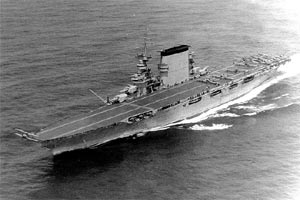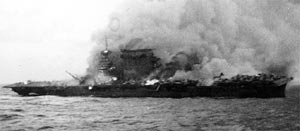USS Lexington (CV-2)
|
|
ja:レキシントン (CV-2) de:USS Lexington (CV-2) sl:USS Lexington (CV-2
 Lexington launching torpedo planes | |
| Career | Missing image USN-Jack.png USN Jack |
|---|---|
| Laid down: | 8 January 1921 |
| Launched: | 3 October 1925 |
| Commissioned: | 14 December 1927 |
| Fate: | Sunk by Japanese at the Battle of the Coral Sea, 8 May 1942 |
| General Characteristics | |
| Displacement: | 41,000 tons (50,900-1942) |
| Length: | 888 ft |
| Beam: | 105.5 ft |
| Draft: | 32 ft (34.25 ft-1942) |
| Main Engines: | Westinghouse Turbine-Electric, 212,000 SHP |
| Speed: | 34.25 knots (reached 36.15 knots in service) |
| Complement: | 2,122 officers and men |
| Armament: | 8 x 8-inch guns, 12 x 5-inch guns |
| Aircraft: | 81 |
The fourth USS Lexington (CV-2), nicknamed the "Gray Lady" or "Lady Lex", was the second aircraft carrier of the United States Navy.
She was originally designated CC-1 and laid down as a battle cruiser 8 January 1921 by Fore River Shipbuilding Company, Quincy, Massachusetts, authorized to be completed as an aircraft carrier 1 July 1922, launched 3 October 1925, sponsored by Mrs. Theodore Douglas Robinson (wife of the Assistant Secretary of the Navy), and commissioned 14 December 1927, Captain Albert W. Marshall in command. While listed officially as 33,000 tons to comply with treaty requirements, both Lexington and Saratoga were actually over 40,000 tons at completion. This "savings" of tonnage allowed for the later construction of the Ranger in 1933–1934.
After fitting out and shakedown, Lexington joined the battle fleet at San Pedro, California, 7 April 1928. Based there, she operated on the west coast with Aircraft Squadrons, Battle Fleet, in flight training, tactical exercises, and battle problems. Each year she participated in fleet maneuvers in Hawaii, in the Caribbean, off the Panama Canal Zone, and in the eastern Pacific. In the fall of 1941 she sailed with the battle force to the Hawaiians for tactical exercises.
On 7 December 1941 Lexington was at sea with Task Force 12 carrying marine aircraft from Pearl Harbor to reinforce Midway when word of the Japanese attack on Pearl Harbor was received. She immediately launched search planes to hunt for the Japanese fleet, and at midmorning headed south to rendezvous with Indianapolis and Enterprise task forces to conduct a search southwest of Oahu until returning to Pearl Harbor 13 December.
Lexington sailed next day to raid Japanese forces on Jaluit to relieve pressure on Wake Island; these orders were canceled 20 December, and she was directed to cover the Saratoga force in reinforcing Wake. When the island fell 23 December, the two carrier forces were recalled to Pearl Harbor, arriving 27 December.
Lexington patrolled to block enemy raids in the Oahu–Johnston–Palmyra triangle until 11 January 1942, when she sailed from Pearl Harbor as flagship for Vice Admiral Wilson Brown commanding Task Force 11. On 16 February, the force headed for an attack on Rabaul, New Britain, scheduled for 21 February; while approaching the day previous, Lexington was attacked by two waves of enemy aircraft, nine planes to a wave. The carrier's own combat air patrol and antiaircraft fire splashed 17 of the attackers. During a single sortie Lieutenant Edward O'Hare won the Medal of Honor by downing five planes.
Her offensive patrols in the Coral Sea continued until 6 March, when she rendezvoused with Yorktown's Task Force 17 for a thoroughly successful surprise attack flown over the Owen Stanley Mountains of New Guinea to inflict heavy damage on shipping and installations at Salamaua and Lae 10 March. She now returned to Pearl Harbor, arriving 26 March.
Lexington's task force sortied from Pearl Harbor 15 April, rejoining TF 17 on 1 May. As Japanese fleet concentrations threatening the Coral Sea were observed, Lexington and Yorktown moved into the sea to search for the enemy's force covering a projected troop movement; the Japanese must now be blocked in their southward expansion or sea communication with Australia and New Zealand would be cut, and the dominions threatened with invasion. The battle of the Coral Sea was the result.
On 7 May searchplanes reported contact with an enemy carrier task force, and Lexington's air group flew an eminently successful mission against it, sinking light carrier Shoho. Later that day, 12 bombers and 15 torpedo planes from still-unlocated heavy carriers Shokaku and Zuikaku were intercepted by fighter groups from Lexington and Yorktown, who splashed nine enemy aircraft.
On the morning of the 8th, a Lexington plane located the Shokaku group; a strike was immediately launched from the American carriers, and the Japanese carrier was heavily damaged.

The enemy penetrated to the American carriers at 11:00, and 20 minutes later Lexington was struck by a torpedo to port. Seconds later, a second torpedo hit to port directly abreast the bridge. At the same time, she took three bomb hits from enemy dive bombers, producing a 7 degree list to port and several raging fires. By 13:00 her skilled damage control parties had brought the fires under control and returned the ship to even keel; making 25 knots, she was ready to recover her air group. Then suddenly Lexington was shaken by a tremendous explosion, caused by the ignition of gasoline vapors below, and again fire raged out of control. At 15:58 Captain Frederick Carl Sherman, fearing for the safety of men working below, secured salvage operations, and ordered all hands to the flight deck. At 17:01, he ordered, "abandon ship," and the orderly disembarkation began. Men going over the side into the warm water were almost immediately picked up by nearby cruisers and destroyers. Admiral Aubrey Wray Fitch and his staff transferred to cruiser Minneapolis; Captain Sherman and his executive officer, Commander Morton T. Seligman insured all their men were safe, then were the last to leave.
Lexington blazed on, flames shooting hundreds of feet into the air. Destroyer Phelps closed to 1500 yards and fired two torpedoes into her hull; with one last heavy explosion, Lexington sank at 19:56, in Template:Coor dm.
Lexington received two battle stars for her World War II service.
Lexington and her sister Saratoga were turboelectric drive ships with steam turbines spinning generators that powered the slower speed main drive motors. Lexington's engines provided electricity to Tacoma, Washington for thirty days during a power shortage in the winter of 1929/1930.
See also
- USS Lexington for other Navy ships of the same name.
- List of U.S. Navy losses in World War II
External links
- USS Lexington CV-2 Memorial Page (http://uss_lexington_cv2.tripod.com)
- Navy photographs of Lexington (CV-2) (http://www.history.navy.mil/photos/sh-usn/usnsh-l/cv2.htm)
- Coral Sea photographs (http://www.history.navy.mil/photos/events/wwii-pac/coralsea/cs-5m.htm)
This article includes text from the public domain Dictionary of American Naval Fighting Ships.
| Lexington-class aircraft carrier |
| Lexington | Saratoga |
| Lexington-class battlecruisers |
| Constellation | Ranger | Constitution | United States |
| List of aircraft carriers of the United States Navy |
